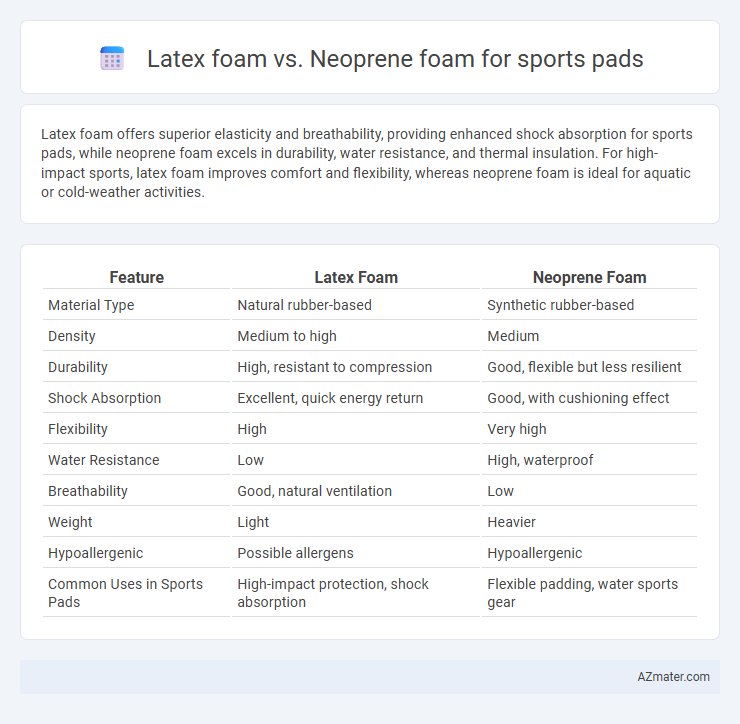Latex foam offers superior elasticity and breathability, providing enhanced shock absorption for sports pads, while neoprene foam excels in durability, water resistance, and thermal insulation. For high-impact sports, latex foam improves comfort and flexibility, whereas neoprene foam is ideal for aquatic or cold-weather activities.
Table of Comparison
| Feature | Latex Foam | Neoprene Foam |
|---|---|---|
| Material Type | Natural rubber-based | Synthetic rubber-based |
| Density | Medium to high | Medium |
| Durability | High, resistant to compression | Good, flexible but less resilient |
| Shock Absorption | Excellent, quick energy return | Good, with cushioning effect |
| Flexibility | High | Very high |
| Water Resistance | Low | High, waterproof |
| Breathability | Good, natural ventilation | Low |
| Weight | Light | Heavier |
| Hypoallergenic | Possible allergens | Hypoallergenic |
| Common Uses in Sports Pads | High-impact protection, shock absorption | Flexible padding, water sports gear |
Introduction to Sports Pads: Choosing the Right Foam
Latex foam and neoprene foam are popular materials for sports pads due to their unique impact absorption and flexibility properties. Latex foam offers superior breathability and natural resilience, making it ideal for prolonged athletic use, while neoprene foam provides excellent water resistance and cushioning, perfect for aquatic or high-impact sports. Selecting the right foam depends on the sport's specific demands, including shock absorption, moisture control, and durability.
What is Latex Foam? Composition and Features
Latex foam, derived primarily from natural rubber or synthetic latex, consists of a network of open-cell structures offering exceptional elasticity and resilience. Its composition enables superior cushioning, breathability, and moisture resistance, making it ideal for sports pads requiring comfort and impact absorption. Known for its durability and hypoallergenic properties, latex foam provides long-lasting support while maintaining ventilation to reduce heat buildup during physical activities.
Neoprene Foam Explained: Structure and Benefits
Neoprene foam, composed of synthetic rubber with a closed-cell structure, offers excellent elasticity, water resistance, and thermal insulation, making it ideal for sports pads. Its durable and flexible properties provide superior shock absorption and comfort during high-impact activities, outperforming latex foam in moisture management and longevity. The uniform cell structure of neoprene foam enhances breathability while maintaining protection, ensuring optimal performance and durability in athletic gear.
Comfort and Cushioning: Latex vs Neoprene
Latex foam provides superior breathability and natural elasticity, enhancing comfort and offering responsive cushioning ideal for prolonged sports activities. Neoprene foam delivers excellent durability and water resistance, with a denser structure that absorbs impact effectively but may retain heat, potentially reducing comfort during intense exercise. Choosing between latex and neoprene depends on prioritizing either ventilation and flexibility or durability and impact absorption in sports pad design.
Durability Comparison: Which Foam Lasts Longer?
Latex foam exhibits superior durability compared to neoprene foam in sports pads, maintaining its resilience and cushioning properties over extended periods of high-impact use. Neoprene foam, while flexible and water-resistant, tends to degrade faster due to exposure to UV light, sweat, and repeated compression. This makes latex foam a longer-lasting material choice for sports pads requiring sustained performance and structural integrity.
Breathability and Moisture Management
Latex foam offers superior breathability with its open-cell structure, allowing efficient air circulation that keeps sports pads cool and dry during intense activity. Neoprene foam, while providing excellent cushioning and durability, tends to trap heat and moisture due to its closed-cell design, resulting in less effective moisture management and potential discomfort. For athletes prioritizing ventilation and sweat-wicking properties, latex foam is the optimal choice for enhanced comfort and performance.
Allergen Potential and Skin Sensitivity
Latex foam often triggers allergic reactions due to natural proteins present in the material, posing risks for individuals with latex allergies or sensitive skin, whereas neoprene foam is typically hypoallergenic and less likely to cause irritation. Neoprene's synthetic composition offers superior resistance to bacterial growth and moisture retention, reducing the risk of skin issues during prolonged use in sports pads. Selecting neoprene foam minimizes allergen exposure and supports better skin health for athletes with sensitivities or known latex allergies.
Impact Protection and Shock Absorption
Latex foam offers superior impact protection and shock absorption due to its high elasticity and ability to return to its original shape quickly, making it ideal for sports pads that require cushioning against repeated impacts. Neoprene foam provides excellent durability and water resistance, with moderate shock absorption, but it tends to compress over time, which may reduce its impact protection effectiveness. Athletes often prefer latex foam for dynamic movements demanding enhanced energy dispersion and comfort, while neoprene is favored for stable support in wet or humid conditions.
Environmental Impact: Sustainability and Recycling
Latex foam, derived from natural rubber, offers superior sustainability due to its renewable source and biodegradability, making it an eco-friendly choice for sports pads. Neoprene foam, a synthetic material made from petrochemicals, poses greater environmental concerns due to its non-biodegradable nature and challenges in recycling processes. Choosing latex foam over neoprene significantly reduces environmental footprint and supports recycling initiatives in sports equipment manufacturing.
Cost Comparison and Value for Athletes
Latex foam sports pads typically cost more upfront than neoprene foam but offer superior breathability, durability, and shock absorption, providing long-term value for athletes seeking enhanced performance and injury prevention. Neoprene foam is more affordable and widely available, making it a budget-friendly option for casual athletes or those prioritizing flexibility and water resistance over longevity. The choice depends on balancing initial investment against durability and comfort needs, with latex foam often delivering greater overall value despite higher initial costs.

Infographic: Latex foam vs Neoprene foam for Sports pad
 azmater.com
azmater.com